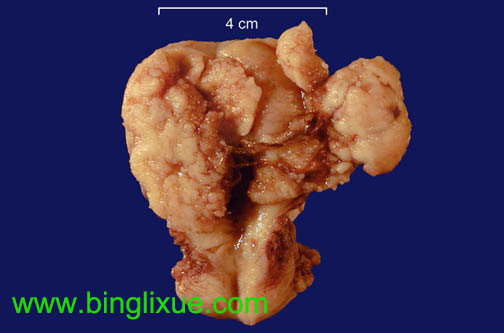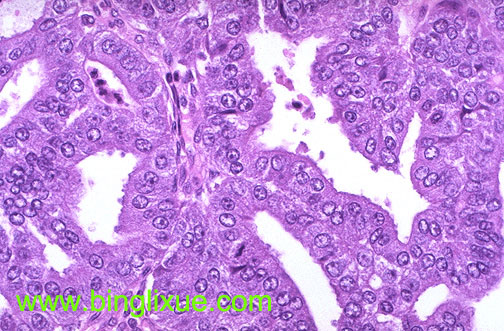


图示子宫内膜腺癌。棕褐色不规则的肿块充满子宫腔并向肌层浸润。大多数病人发病年龄在55-60岁之间,极少发生于40岁以下。主要危险因素是长期过多雌激素的刺激。雌激素升高导致内膜增生,并促使癌发生。无排卵性月经周期、肥胖、分泌雌激素的卵巢肿瘤、未育、外源性雌激素治疗,都能增加子宫内膜腺癌发生的危险。高血压、糖尿病也是其危险因素。绝经期后不规则的阴道流血可能是其仅有的征象。子宫无明显增大。大多数子宫内膜腺癌局限于子宫(即Ⅰ期),其五年存活率为90%。
The irregular tan mass filling the endometrial cavity and infiltrating into the myometrium of the uterus is an endometrial adenocarcinoma, seen to be moderately differentiated microscopically. Most patients with this neoplasm are 55 to 65 years of age, and rarely younger than 40 years. The major risk factor for this carcinoma stems from prolonged estrogen stimulation. Conditions that lead to increased estogenic exposure can produce endometrial hyperplasia, from which a cancer can arise. Anovulatory cycles, obesity, estrogen-producing ovarian tumors, low parity or nulliparity, and exogenous estrogen therapy can all increase the risk for endometrial adenocarcinoma in this manner. Hypertension and diabetes mellitus are also risk factors. Irregular postmenopausal bleeding may be the only sign, and the uterus may not be significantly enlarged. Most endometrial adenocarcinomas are confined to the uterus (Stage I) with a 5-year survival around 90%.